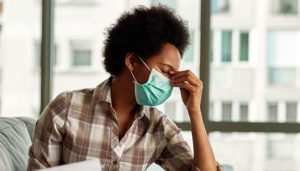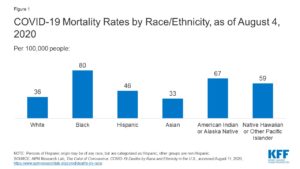Overcoming Pandemic Fatigue to Promote Health Equity
November 23, 2020 • Uncategorized
As the holidays fast approach and 2020 continues to give us a run for our money, many people are feeling the effects of pandemic fatigue. Pandemic fatigue occurs when people grow tired of practicing measures meant to slow the spread of COVID-19, such as social distancing, wearing a mask, staying away from large gatherings, etc. The feelings of social isolation, frustration, lack of motivation, resignation, and general irritability are all signs that you may be experiencing pandemic fatigue.
 COVID-19 cases in the United States continue to surge as we seem to be at the beginning of a second wave, although it may seem that we never truly defeated the first wave. With the holiday spirit slowly creeping into our everyday conversations and thoughts, it’s important to consider the potential effects and develop strategies to remain safe and combat pandemic fatigue.
COVID-19 cases in the United States continue to surge as we seem to be at the beginning of a second wave, although it may seem that we never truly defeated the first wave. With the holiday spirit slowly creeping into our everyday conversations and thoughts, it’s important to consider the potential effects and develop strategies to remain safe and combat pandemic fatigue.
While Thanksgiving, Hanukkah, Kwanza and Christmas are typically holidays where families and friends gather to eat and fellowship with one another, the CDC recommends limiting your interactions and travel during this time.
Strategies to enjoy the holidays and fight pandemic fatigue, while also doing your part to slow the spread of COVID-19 include:
- Limit your gatherings with people outside of your household. Gatherings of 10 or fewer people are associated with a lower risk of transmission.
- Self-care. The holidays are times when we forget about taking care of ourselves, because we are focused on being a part of the holiday spirit. Make sure to stay up-to-date with all medications and doctor’s appointments, exercise regularly, don’t overeat, and make sure to get enough sleep.
- Be selective. When choosing to gather in groups, make wearing a mask mandatory for everyone, frequently disinfect commonly touched surfaces, advise those that don’t feel well to stay home, choose activities or locations that will make it easier to maintain social distancing precautions, and make sure everyone is regularly washing their hands. Gather outdoors and in shorter durations whenever possible.
- Be gracious. This year has been hard for a lot of people. It is ok not to be ok right now. Setting realistic expectations of yourself and others can help to combat the feelings of being overwhelmed. Take a moment to yourself, try deep breathing exercises, and don’t forget that your mental health plays a part in your physical health.
- Connect virtually. Stay in touch with friends and family virtually. Video conferencing platforms, such as Skype, FaceTime, and Zoom allow for people to stay connected from all over the world. In fact, Zoom is lifting the 45 minute limit on free Zoom calls on Thanksgiving. Try creating a schedule to remain consistently in touch with those closest to you.
COVID-19 and Racial and Ethnic Minorities1
Throughout the pandemic, trends in COVID-19 infection, hospitalization, and death rates have shown disproportionate effects on racial and ethnic minority populations.
 Racial and ethnic minorities are at an increased risk of becoming ill and dying from the virus due to several social-ecological factors: healthcare access and utilization, occupation, housing, and educational, income, and wealth gaps.
Racial and ethnic minorities are at an increased risk of becoming ill and dying from the virus due to several social-ecological factors: healthcare access and utilization, occupation, housing, and educational, income, and wealth gaps.
- Decreased healthcare access and utilization result from factors including lack of transportation, inability to take time off work or obtain childcare, communication and language barriers, distrust in the healthcare system, and cultural differences between patients and providers.
- The essential workforce, consisting of healthcare workers, farming, grocery stores, and public transportation have a large proportion of minority workers. These essential positions place the workers at increased risk of contracting COVID-19 due to the public nature of the jobs; as well as the inability to take paid sick days, properly social distance, and work from home.
- Households with a greater number of co-habitants or families that live in crowded dwellings increase the risk of COVID-19 transmission. In addition, the financial strain caused by COVID-19 has resulted in the loss of employment, which contributes to unstable housing and the increase of household size due to the sharing of housing and resources.
- Lack of access to high-quality education creates a domino effect in terms of income and wealth gaps. Without access to adequate and complete education, it becomes challenging to obtain and maintain gainful employment. Job availability to those that fall in this category are typically in industries with increased risk of exposure to COVID-19 and does not allow for the time or monetary flexibility that would be needed if the employee does fall ill.
With increased demand being placed on essential workers as the holidays approach, particularly those in service industries, it is important to remain mindful of public health recommendations amidst the continuing pandemic. The ultimate goal is to keep everyone as safe as possible. It is on all of us to do our parts to help those that are at a disproportionate risk of COVID-19.
Stay motivated. Stay safe. Happy Holidays.
Author:
Ashley Lamar, MPH, CPH: Ms. Lamar is an HSC alumnus and received her MPH degree from the College of Public Health. She is a member of the CPH Equity, Diversity, and Inclusion committee and is employed by the JPS division of Injury and Violence Prevention.
Editor:
Emily Spence, PhD, Associate Dean for Community Engagement and Health Equity
Citation:
- Centers for Disease Control and Prevention (CDC). (July 24). Health Equity Considerations and Racial and Ethnic Minority Groups. Retrieved November 16, 2020, from https://www.cdc.gov/coronavirus/2019-ncov/community/health-equity/race-ethnicity.html
Image Credits:
Photo: Photo credit: Drazen Zigic, creator. Retrieved from www.hopkindsmedicine.org
Graph: Figure 1 image credit: KFF (2020) Racial disparities in COVID-19: Key findings from available data and analysis. Retrieved from https://www.kff.org/report-section/racial-disparities-in-covid-19-key-findings-from-available-data-and-analysis-issue-brief/
Click through image: Getty images
Georgie Institute of Technology, COVID-19 Risk Assessment Planning Tool


Social media